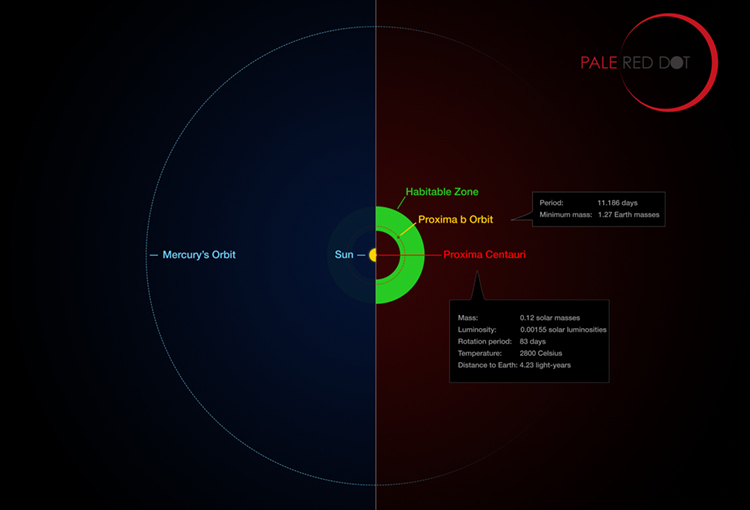^Top image: This artist’s impression shows the red dwarf star Proxima Centauri, the closest star to our solar system, on the red horizon of Proxima b, a planet scientists think could support life. The double star Alpha Centauri AB appears to the upper right of Proxima Centauri. Credit: ESO/M. Kornmesser
On August 24, scientists from the European Southern Observatory (ESO) announced that they had discovered an extrasolar (beyond our solar system) planet, or exoplanet, that may harbor conditions favorable to life. This exoplanet, called Proxima b, orbits Proxima Centauri, the star closest to the sun. Astronomers have nicknamed Proxima b the “pale red dot,” a play on Earth’s appearance as a “pale blue dot” in a distant photo taken by the Voyager 1 space probe in 1990. Astronomers believe that Proxima Centauri, a red dwarf star, will cast its close-orbiting planet in a pale red glow. The search for a planet orbiting Proxima Centauri, which began just seven months ago, was dubbed the “Pale Red Dot” campaign.
Proxima Centauri is part of a three-star system called Alpha Centauri. Two of the stars, Centauri A and Centauri B, are roughly the size of the sun and orbit each other. Proxima Centauri is a much smaller red dwarf star and orbits the larger pair of stars every million years or so.

^Proxima b (nicknamed the “pale red dot” by astronomers) and its orbit around Proxima Centauri are compared with the same region of our own solar system. Proxima Centauri is smaller and cooler than the sun, and Proxima b orbits much closer to its star than Mercury orbits the sun. A planet in the green habitable zone could possibly have liquid water, which could possibly support life. Credit: ESO/M. Kornmesser/G. Coleman
The newly discovered exoplanet, Proxima b, is at least 1.3 times the size of Earth. Its size indicates that it is probably a rocky planet, like Earth and Mars. It orbits Proxima every 11 Earth days (Mercury, the closest planet to the sun, completes a year every 88 Earth days). If Proxima Centauri were a star like our sun, the planet would be little more than a charred husk. But red dwarf stars are small and relatively cool. Consequently, it is possible that liquid water could exist on the exoplanet’s surface. Scientists call this region around a star, where temperatures are suitable for liquid water, its habitable zone. Liquid water is a necessary building block for life as we know it.
If red dwarf stars can harbor habitable worlds, then the odds that life exists elsewhere in the universe increase significantly. Red dwarfs make up about 70 percent of the stars in the universe. They also burn slowly and steadily, for up to 10 trillion years. In contrast, the sun has a stable lifespan of only 10 billion years. As a result, if favorable conditions exist, life could have countless chances to form over countless eons.
Astronomers still have a lot to learn about Proxima b and whether it can host life. It might lack an atmosphere or get bombarded by powerful X ray blasts from Proxima. The James Webb Space Telescope (JWST), to be launched in 2018, should answer some of these questions. It will be able to determine the exoplanet’s composition and whether it has an atmosphere. JWST will also gather more information on the planet’s size and makeup. Future space telescopes may even be powerful enough to see the “pale red dot” directly.
Most exoplanets are too far away to be explored by spacecraft from Earth. They orbit stars many light-years away. A light-year is the distance light travels in a year, or about 5.88 trillion miles (9.46 trillion kilometers). Nothing can travel faster than the speed of light. Proxima Centauri, however, is just 4.2 light-years away, tantalizingly close in astronomical terms. But the fastest spacecraft ever created have reached just tiny fractions of the speed of light. Using such technology, a traditional space probe would still take thousands of years to reach the system.
A private initiative called Breakthrough Starshot, however, has proposed launching a tiny spacecraft to the system that would take as little as 20 years to get there. The probe would be only a gram or two (the equivalent of less than an ounce on Earth) and be propelled by large Earth-based lasers to 20 percent of the speed of light. There are many technical hurdles to be overcome, however, and the group does not anticipate launching a probe for at least another 20 years, but there is hope that the planet could be explored close-up before 2100. Soon, we may get to say hello to our closest potential neighbor. Will it say hi back?
View more Behind the Headline stories in World Book Online!
When you need fast, reliable information for homework, reports, or just a lingering question, World Book Online is the place to go.
- A colorful, approachable look and feel, designed for kids, and articles written at your student's level
- Easy access on smartphones and tablets
- Five complete databases for multiple research levels
- Illustrations, maps, audio files, videos, eBooks, primary source documents, and more
Learn More | Buy Now